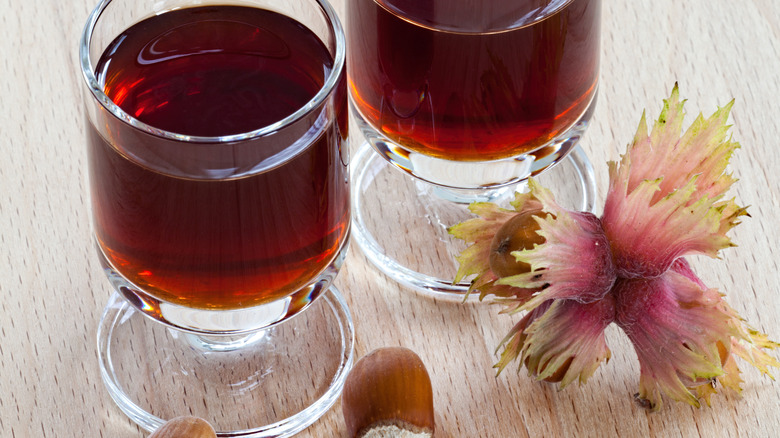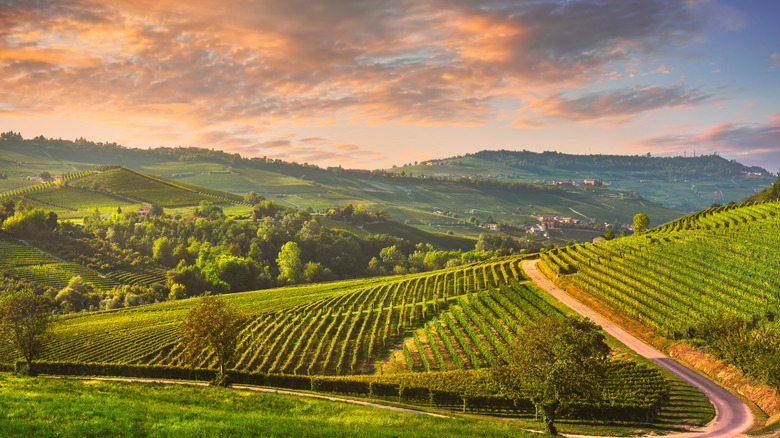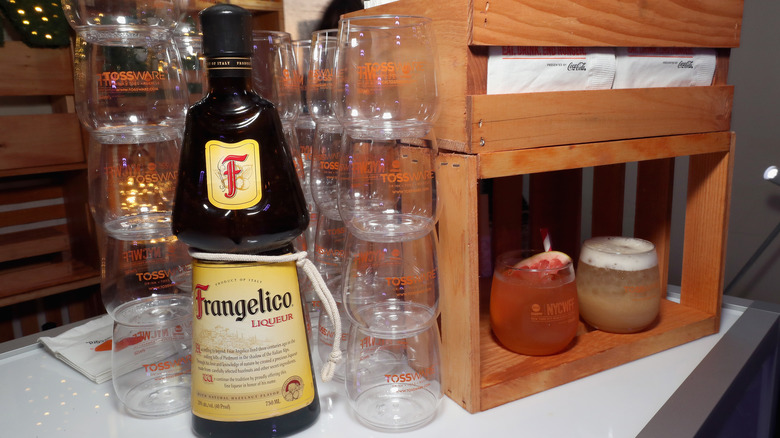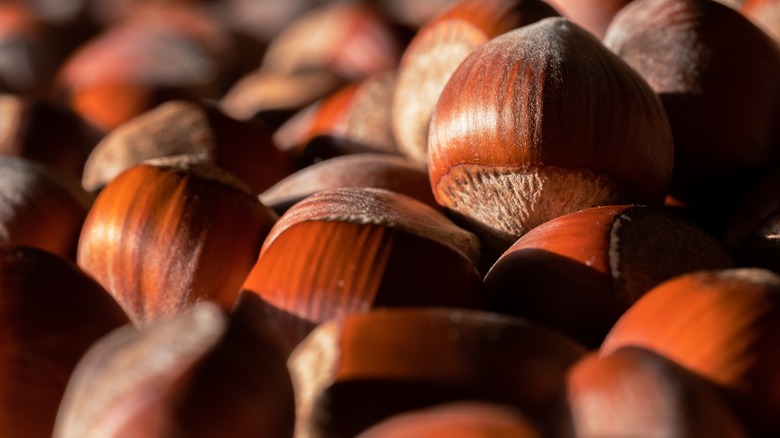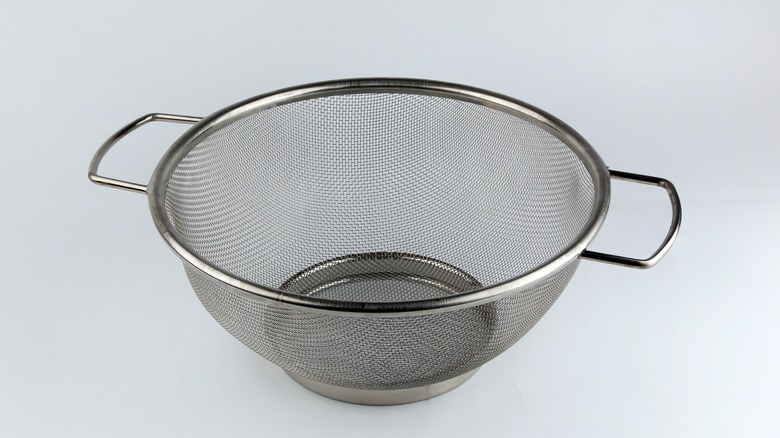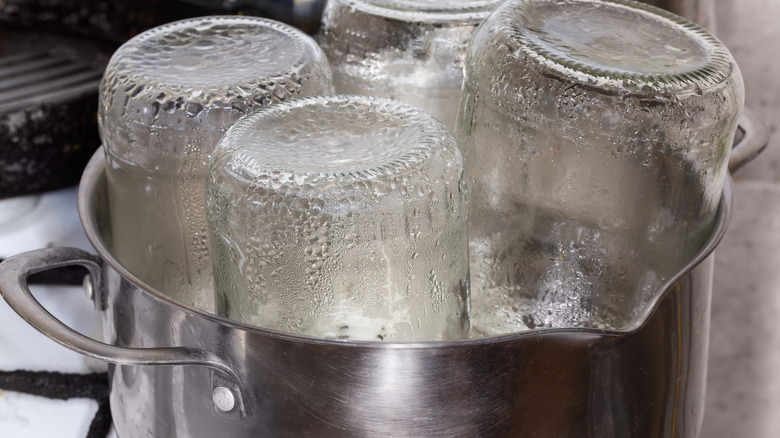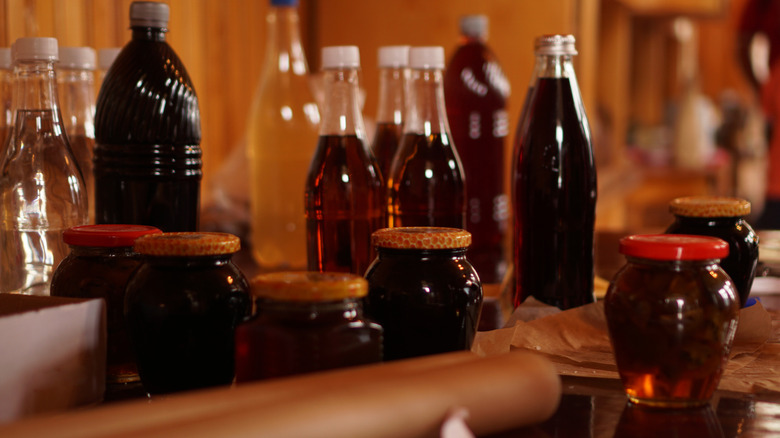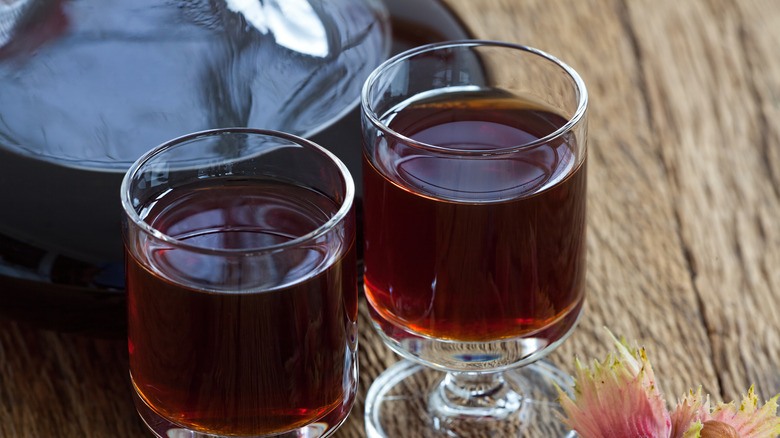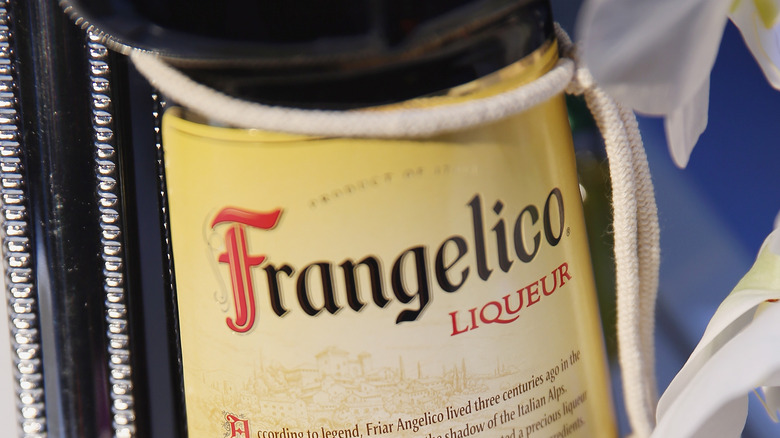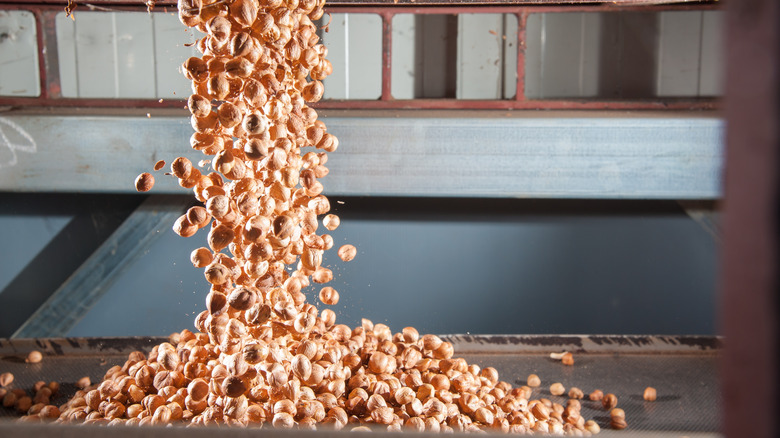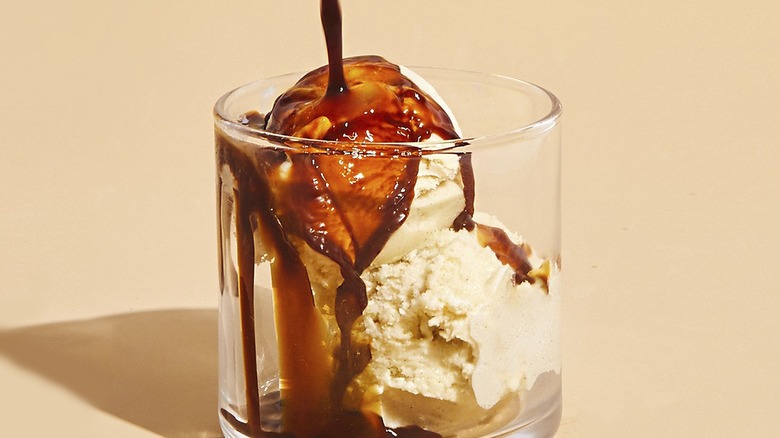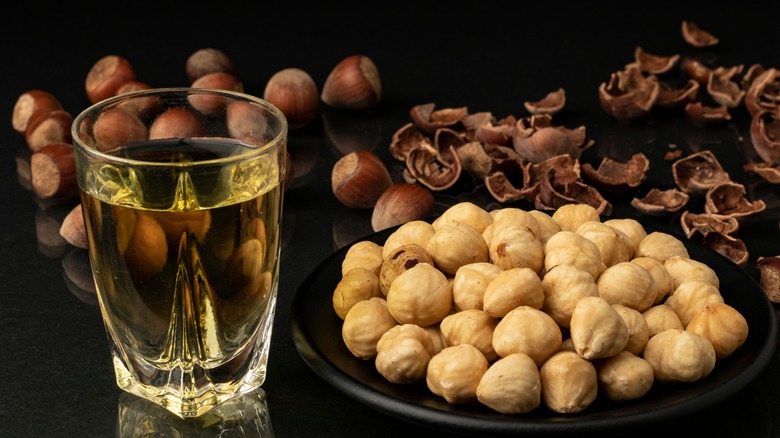Should You Buy Or Make Your Own Hazelnut Liqueur?
Hazelnut liqueur is a sweet liqueur that is quite popular. And what is liqueur? It's flavored, sweetened liquor made by "infusion, extraction, distillation, or smoking." When made at home, the most common method is infusion. Store-bought liqueurs can be made by any of those methods. Frangelico is the most iconic brand of hazelnut liqueur, though it is not the only one. How does hazelnut liqueur taste? Though it depends on the exact flavorings used, Frangelico is nutty and chocolaty with a hint of coffee. These flavors make it a wintertime favorite for cocktails, baked goods, or straight up sipping.
Even with so many brands available, you might still be curious about making your own hazelnut liqueur. There are pros and cons with any DIY endeavor — ultimately, the decision will lie in which column stacks higher for you. This article should help build those (pros and cons) lists and either help you choose a brand to buy or give you some great tips for making your own hazelnut liqueur. And hey, there's no rule that says you can't do both!
History
The Frangelico brand has only been around since 1978, but hazelnut liqueur likely dates back about 300 years. Legend has it — at least by the Frangelico company – the liqueur was created by a Christian monk named Fra' Angelico. Frangelico originates in the Piedmont region of Italy, where monks are said to have used wild hazelnuts. In fact, the company's famous bottle pays homage to the liqueur's origin; it's shaped like a monk (via OU Kosher).
But the history of monks and alcohol is not limited to Frangelico. Per an article published in The Conversation, much of the spread of alcohol can be traced back to Christian missionaries and monks. Though people have been making wine since about 6,000 BCE, Catholic missionaries brought grapes to the Americas in the 18th century. The article even credits Father Junípero Serra with as the "father" of the entire California wine industry. Moreover, the invention of the world-famous Chartreuse liqueur is attributed to the Carthusian order of monks.
It may seem odd that these religious folks have had such a large hand in the distribution of alcohol. However, a lot of it comes down to the fact that they had the space and time to grow the necessary crops and house the equipment for distillation and infusion. Furthermore, hundreds of years ago, alcohol was safer to drink than water, so there was a real need for these intoxicating beverages that killed off most of the bacteria in water.
Brands/Cost
Hazelnut liqueur is one of the most popular types of liqueurs, but what are the most popular brands of hazelnut liqueur? While Frangelico has become a proprietary eponym for hazelnut liqueur (like "Kleenex" for "tissue"), Frangelico is not the only brand available to you. Eat Dat says that apart from Frangelico, Baileys, Fratello, Gabriel Boudier, Giffard, Adamsons of Anglesey, and Luxardo Angioletto are commonly-sold labels in the United States. Hazelnut liqueur is easily accessible; you can find it in most supermarkets or liquor stores and through delivery services.
Per Wine Searcher, the two spendiest hazelnut liqueurs in that batch are Frangelico at an average of $31 for 750 milliliters and Baileys, at an average of $29 for 750 milliliters. The most affordable is Luxardo Angioletto at an average of $24 for a 750-milliliter bottle. These prices will vary by region and store. There are, of course, pricier and also less expensive brands on the market. If you are looking for an affordable and easy-to-find liqueur that tastes luxurious, storebought hazelnut liqueur is a great choice.
Tips for making it yourself
Making your own hazelnut liqueur is straightforward. However, it will take a bit of trial and error and patience. Creating hazelnut liqueur is not very laborious in that you're not distilling (making) alcohol. Producing hazelnut liqueur is simply infusing a neutral-tasting liquor with hazelnuts and other flavorings.
According to Distiller, you do not need much special equipment to infuse your own alcohol. The outlet recommends measuring cups, a kitchen scale, and an alcohol hydrometer so you can measure the alcohol by volume (ABV) of your drink. The Spice House recommends storing your infusion in wide-mouthed glass containers to allow for easier removal of additions.
The simplest base alcohol to use is vodka since its neutral flavor allows you to control your flavorings. But brandy is a great flavor addition to hazelnut liqueur. When thinking of other seasonings to add to your infusion, think about how the ingredients pair with your main one — hazelnuts. For example, vanilla and chocolate work well.
When adding the hazelnuts to your liquor for infusion, crush them a bit so that their flavor releases into the alcohol. Use whole spices instead of powdered ones. You can also decide if and how much sugar to add to your concoction.
Remember that the infusion will become more flavorsome with time. If you drink it right away — we get it, hazelnut liqueur is delicious – it will not have absorbed the things you added. So practice a little self-control, because making your own liqueur is a great choice.
Mistakes to avoid when DIYing
Though DIYing alcohol is a fun activity, there are some mistakes you need to avoid when making your own drink infusions. While it could take several days for your hazelnut liqueur infusion to be ready, don't let it infuse for too long. And if you're worried it might over-infuse, you can always pop it into the refrigerator to slow the process.
Once your infusion is ready, you need to strain it well — a fine mesh sieve followed by a coffee filter works well. If food particles are left in the liqueur, you risk your homemade hazelnut liqueur spoiling.
Use high-quality ingredients for your add-ins, but do not bother splurging on the alcohol itself. A medium-grade liquor is perfect for making infusions. Finally, do not make too much hazelnut liqueur when you are first starting out and experimenting with flavors. Making small amounts and keeping notes of what you have used will allow you to recreate the recipe later.
By avoiding these mistakes, you'll streamline the process of making your own hazelnut liqueur, ensuring that the process goes off without a hitch. After all, you want to end up with a tasty product, something worth your time, money, and effort.
Keep equipment clean
While you can never be 100% sure you are not inviting foodborne pathogens to the party when you infuse liqueur at home, there are steps you can take to mitigate the risk. North Carolina State University recommends sterilizing your equipment by washing it for at least 10 minutes before you begin the infusion process. If any bacteria is left in your containers when you begin making your hazelnut liqueur, chances are they will multiply.
None of your infusion flavorings should have blemishes like bruises — those are prime locations for bacteria to grow. If you're really worried about bacteria, you can keep your infusion in the fridge; just know that the process will take longer. While it is true that alcohol is good at killing pathogens, it is not a panacea. Further, the amount of time it takes for pathogens to die off in alcohol varies (if they die at all). Therefore, take all necessary precautions when making your own hazelnut liqueur. If the risk is too stressful, go with store bought, which doesn't need to be refrigerated.
Shelf life
One of the benefits of buying hazelnut liqueur is that its shelf-life is indefinite. In fact, Still Tasty states, "To maximize the shelf life of hazelnut liqueur for quality purposes, store in a cool dry area away from direct heat or sunlight; keep tightly closed when not in use." Storing with the lid closed tightly will keep your liqueur tasting its best. Be aware that after being opened, liqueur does begin to evaporate "and some flavor may be lost over time ..." Naturally, if your hazelnut liqueur smells funny or looks strange, do not drink it.
While store-bought hazelnut liqueur has a long shelf life, the same isn't necessarily true for DIY. Eating Expired notes that depending on what is in your homemade liqueur, it may keep for only a few days or up to a year. As with store bought, check for discoloration and strange odors before imbibing.
Keep in mind, though, that with either type of liqueur, the main problem with keeping it for too long is loss of quality rather than safety. Even if everything smells and looks fine, if you've had a bottle for a while, taste it before serving.
Best reasons to DIY
DIYing, in general, rose in popularity once the COVID-19 pandemic hit, not just based on need but because people realized making their own products could be a fun and rewarding hobby — not to mention possibly distracting from negative thoughts and feelings about this particular period in time. Making hazelnut liqueur is no exception to that fun. Infusing your own liqueur allows you to control the exact flavor, and it might even taste more natural. Plus, bottled up nicely, it makes a great gift. You can even throw a DIY party if you want to go all out! You and your friends can get together to make the liqueur and then reconvene for a tasting party when it is ready.
Another reason to make hazelnut liqueur specifically is that the nut (at time of publication) is cheap. According to Oregon Public Broadcasting, market conditions in Turkey (the world's largest hazelnut producer) and shipping restrictions in China have led to plummeting hazelnut prices in the United States. While this is bad news for Oregon growers, who produce 99% of U.S. hazelnuts, it is good for those looking to make their own liqueur.
All in all, the best reason to DIY your hazelnut liqueur is if it sounds fun to you. If you're not going to enjoy the process, there is no benefit to embarking on the journey.
Note: Infusing liqueur is different from distilling your own liquor. The latter is riskier and, "Federal law strictly prohibits individuals from producing distilled spirits at home"
(per the U.S. Department of the Treasury).
Best reasons to buy
Whenever you make infused foods at home, you risk foodborne pathogens entering your food (via North Carolina State University). Not to mention that the cost of DIYing can start to add up. When you consider that you need to use multiple ingredients to make your own hazelnut liqueur and that it has a shorter shelf life than store bought, it is not the most economical choice.
By buying hazelnut liqueur, you will know the exact alcohol by volume (ABV). The Frangelico brand of hazelnut liqueur contains 20% ABV. To measure the ABV of your own infusion, you must use an alcohol meter or do some math. If you decide to go the arithmetic route, Still Spirits states you must first figure out how much alcohol is in the recipe. To do so, subtract the non-alcohol additives from the final volume of the drink. Next, divide the volume of alcohol in your recipe by the volume of your entire recipe. Then, multiply that number by the AVB of your base liquor. For example, if you used vodka that's 40% ABV and you have 400 milliliters of it in a 600-milliliter recipe, your total recipe is around 27% ABV.
Lastly, DIYing your hazelnut liqueur takes planning since it can take at least a week to get the flavor you want, according to Distiller. That means you won't be able to show off your alcohol infusion skills to last-minute guests. If you're looking for an affordable, sure thing, buying your hazelnut liqueur is the way to go.
How is hazelnut liqueur professionally made?
Making an infused liqueur at home is not the same as making it in the factory. Frangelico explains that their process is more-than-slightly different from the one you would use in your own kitchen. First, the company toasts and crushes shelled hazelnuts. Next, it infuses the hazelnuts in a mixture of alcohol and water. The biggest difference between Frangelico's method and DIY is the following step: The alcohol maker distills their hazelnut infusion, making a hazelnut distillate. DIY versions do not involve distillation, which is one reason they are so easy to make.
After creating the hazelnut distillate, Frangelico formulates a concentrate by mixing it with cocoa, vanilla, and coffee distillates and extracts. The company then combines that concentrate with alcohol, sugar, and water before mellowing the mixture for six to eight weeks. While this technique still uses natural products, it is more processed than home infusion methods, which is part of why the store-bought version has a longer shelf life.
How to use
Now that you have procured your hazelnut liqueur, either at the store or by DIYing it, you probably want to know how to use it. Luckily, there are many options. Even though you do not necessarily have to worry about it going bad, it is still best to drink it when it's fresh so it does not lose quality (per Still Tasty).
Of course, you can partake in your hazelnut liqueur straight or mix it with a bit of ice. You can also get creative — if you're still in the mood for a drink, try a pumpkin pie martini recipe. This fall drink uses half-and-half, Frangelico, vanilla-flavored vodka, and pumpkin spice to evoke those "basic" autumnal vibes. If you are looking for something not quite as boozy, consider that hazelnut liqueur is something you should be putting in your milkshake but aren't. Or, try a coffee and hazelnut tipsy affogato recipe; all you need is vanilla ice cream, coffee, and hazelnut liqueur.
But the uses for hazelnut liqueur aren't limited to beverages. For instance, take a chocolate hazelnut pie recipe up a notch with a hit of this delicious liqueur. You can add the drink to all sorts of baked goods, including cookies, cheesecakes, and flourless cakes. Betty Crocker recommends that a good place to start playing around with your recipes is using alcohol in lieu of extracts.
GF, vegan, and keto
What if you have special dietary needs? Should you buy or make your own hazelnut liqueur? When made at home, hazelnut liqueur is gluten-free, vegan, and keto provided the ingredients you use also fit those dietary restrictions. The Frangelico brand also meets these requirements. According to Barnivore, other confirmed vegan hazelnut liqueur brands are Vok and Giffard. The FDA states that all distilled alcohol is gluten-free unless people add gluten post-distillation. By extension, liqueurs in general are safe for those with Celiac and gluten intolerance, but you should always check the ingredients.
Frangelico brand hazelnut liqueur is certified OU kosher, but it is not certified as kosher for Passover. OK lists Noushig (Amoretti) hazelnut liqueurs as kosher. For homemade, if the ingredients and other necessary steps to make it kosher are followed, hazelnut liqueur would also be kosher. Interestingly, according to Frangelico, due to its distillation process, some people with nut allergies may be able to consume their beverage. Of course, always check with your doctor.
